

I came across this device recently and hope you find it interesting also
In 1910 a young Romanian born engineer named Henri Coanda tested a plane he had built powered by the worlds first jet engine of which he was the inventor. The engine was not a Turbo jet which was later invented by Frank Whittle and Von Ohain, but had a gasoline engine driven centrifugal compressor, a combustion chamber and nozzle.
real Player G2 Video download showing the Coanda effect
( if you don't havethe RealPlayer 5.0, you may download it freely at :http://www.real.com/products/player/)
Coanda placed metal plates between the hot jet gases and the plywood fuselage. However instead of deflecting the jet away it deflected it onto the plates, ran along them and set his plane alight. Fascinated, he failed to notice he was approaching a wall at high speed until the last second, pulled back on the stick, became airborne enough to clear the wall, crashed and was thrown clear to watch his plane go up in flames.
More than 20 years later he came to understand precisely the phenomenon which was named after him, the "Coanda Effect".
Coanda jets are generated by blowing a moderate to high pressure gas (such as air) or liquid through a narrow slot over a surface which in some cases may be convexly curved.
The jet runs tangent to the surface and can circulate around 180° bends. This we call the primary jet. Our patentable methods are able to cause the jet to recirculate around 360°.
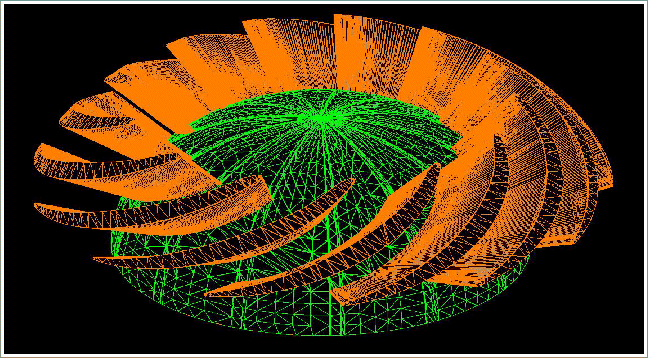
The Coanda jets are never laminar like the flow over an aircraft wing or fan blade. The jets are always highly turbulent. The jet is composed of myriads of localised eddy currents. The speed of the air in the swirling or rotating currents is far higher than the linear velocity of the whole jet stream itself.
Pressure is related to speed as you are now aware of. A round jet issuing from a nozzle entrains ambient air due to its high velocity lowering its pressure which attracts the ambient air by collision and entrapment of molecules.
Coanda jets are ejected from slots and then traverse a hard surface or wall. They are sometimes called a wall jet. This wall after the slot creates a non-symmetrical nozzle.
The velocity of the jet immediately evacuates the molecules between it and the wall. This low pressure region cannot be relieved by ambient inflow as ambient air is on the other side of the jet and so the jet quickly deflects toward and runs tangent to the wall. The average pressure across a Coanda jet is lower than the average pressure across an unbounded round jet.
This means that the average velocity at any point in the Coanda jet is higher than in a conventional jet at the same distance from the slot. It follows then that the pressure is lower at any comparable distance from the slot and the momentum and mass flow are higher at the same points.
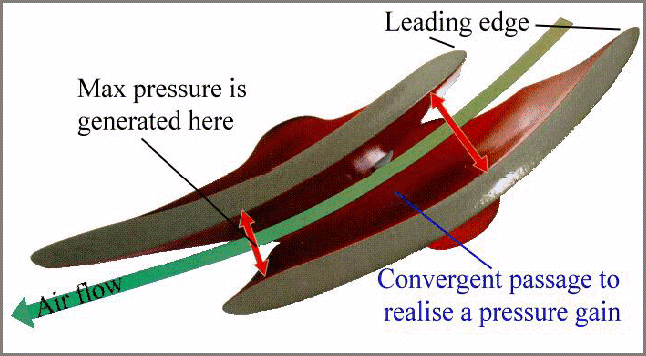
Flow augmentation by entrainment of ambient air is also greater than with a conventional jet because of the pressure gradient caused by the proximity of the hard surface (the wall) tangent to the jet and this is a more efficient means of momentum transfer than mere molecular collision and entrapment as with conventional jets.
The "Coanda Effect" is a fascinating, powerful phenomenon that has been lying almost unused for decades waiting to be exploited commercially. The new "Jet-Fan" now makes it possible to revive the effect in domestic and industrial applications.
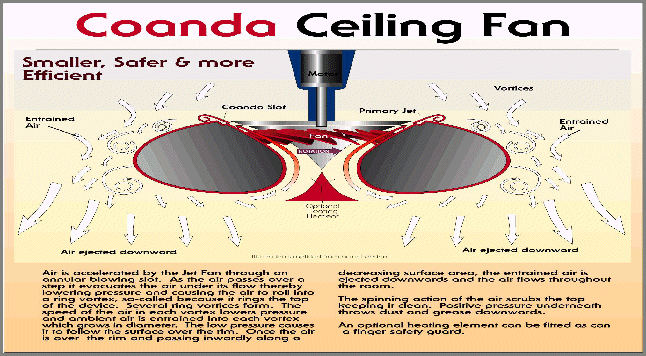
Turbine compressors (as in jet engines),
Computer chip cooling fans.
Ducting for air-conditioning,
Vacuum Cleaners
Ventilation in buildings,
Superchargers for racing cars, aircraft and trucks.
Lift and drive fans for Hovercraft
Ducted fans for aircraft
Jet boats
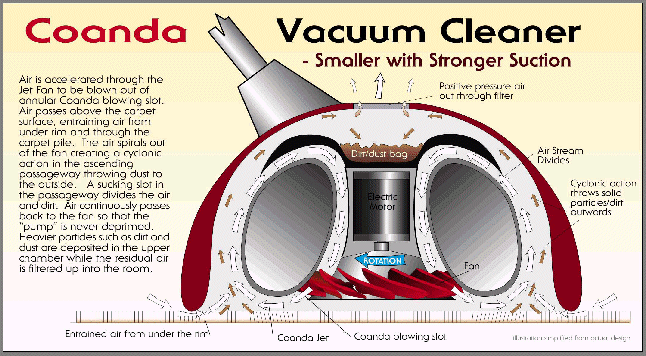
Water pumps for industry, agriculture and automotive
Large mine and power station ventilation and cooling
Radiator fans
Exotic new devices impossible or impractical before the "Jet-Fan".
It is stall free.
It does not require a diffuser or stator blades to realise a pressure gain.
It is more efficient over a wider speed range.
It delivers relatively high pressure air at a high flow rate with high efficiency
with no surging and delivers it axially through a nozzle.
To achieve this the main differences are:-
The blades converge, unlike other fans (Average 6% to 10%)
The "Jet-Fan" does not rotate airfoil blades around but rather rotates convergent passageways ie. each two blades define a passageway.
It has far more blades than a conventional fan.
All blades overlap each other.
It has blades that are much shorter and angled to the axis of rotation.
The gap created by the convergent blades can change during runs.
Each blade has a spigot which extends into a bore in the hub which is aimed at the imaginary dead centre of a sphere which the hub is sliced from. (It has a spherical hub and shroud.) Because high pressure fans tend to leak air back the wrong direction the "Jet-Fan" employs a spherical hub and the blade roots touch the hub for their full length preventing back-flow. The inside of the shroud also has the same spherical aspect which shares the same dead centre as the hub. In this way back-flow near the blade tips is prevented and as all blades overlap significantly any air return is minimised and in fact over almost all its speed and pressure range back-flow is prevented entirely.
When the blades change pitch during runs the blade roots always remain touching the hub and the infinitesimal gap between the blade tips and shroud is not altered.
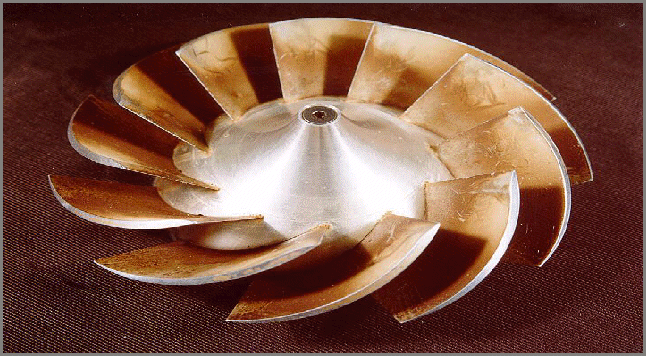
The basic idea of the "Jet-Fan" is very simple.
Blade speed in all fans, especially the centrifugal fans compresses air to some extent. This compression is inevitable and is detrimental to performance as it can cause blade stall by air circulating around the trailing edges. In addition, the air must expand to the average low pressure as it joins the higher speed, lower pressure flow at the trailing edges, subsequently it must have its pressure raised again as it is decelerated through the diffuser or stators. These pressure fluctuations decrease efficiency.
The "Jet-Fan" relies on the fact that the air will be compressed by blade speed just as in all conventional fans but in the case of the "Jet-Fan" the pressure generated is retained without re-expansion.
Blade pitch is configured to maximise compression (with liquids the pressure rises but liquids do not compress).
The blade dynamic pressure on the air can tend to rise by the square as the air is swept further out and so the blades are given a decreasing radius toward the trailing edges to ease the pressure within the passageways. This is to prevent back-flow along the passageways.
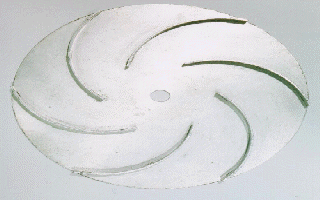
There is therefore a step-down in volume between the blades.
Significant useful pressure is generated by blade speed. The pressure increases by the square of the blade speed increase.
The passageway therefore along its length merely progressively conforms to the lesser space the compressed air occupies and the air is discharged in a pressurised state.
In practice the pressure within the discharge apertures is found to be identical to that immediately aft of the blades and before the air straighteners.
This avoids the abrupt pressure fluctuations found with other fans, the pressure being generated once only and maintained and this avoids the use of a diffuser or stators.
As system resistance increases due to a variable choke in some applications such as ducted fans, or jet boats the fan speed is increased and blades are brought closer together to postpone the stall.
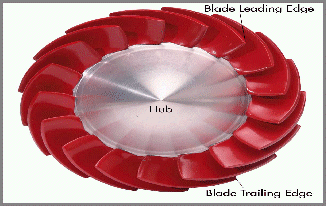
The new "Jet-Fan" is able to produce the same high pressures required for all the applications listed but without the need for a diffuser or stators.
That pressure is delivered immediately from between the fan trailing edges. This feat is achieved by the blade convergence of the "Jet-Fan" which is unlike any other fan.
What all of this means is that the new "Jet-Fan" is able to perform all of the applications listed and many more, better than existing conventional fans.
In addition to producing high pressure air or liquids the "Jet-Fan" has several extra features giving it even more advantages over other fans.
The new "Jet-Fan" has blades that are arranged about a hub that is a slice taken from a true sphere. The blades extend into bores aimed at the imaginary dead centre. This enables the degree of blade convergence (the blade pitch) to be changed during runs. This enables the fan to maintain high pressure and efficiency over a wider RPM range and pressure duty than conventional fans.
The new "Jet-Fan" is also able to do this in very small versions, an achievement not seen before. This means that the existing applications already listed can be performed better by "Jet-Fans" as they are more efficient with higher pressures in smaller diameters and do not require the excess baggage, (diffusers or stators).
Tiny "Jet-Fans" are more efficient than existing computer fans which are normally only around 1% to 5% efficient. Marine And Aviation Transportation
Hovercraft require high volume air flow at moderate pressures. The "Jet Fan" can provide higher pressure when needed such as in heavy seas as it does not stall due to fluctuating back pressure, and it also occupies less space.
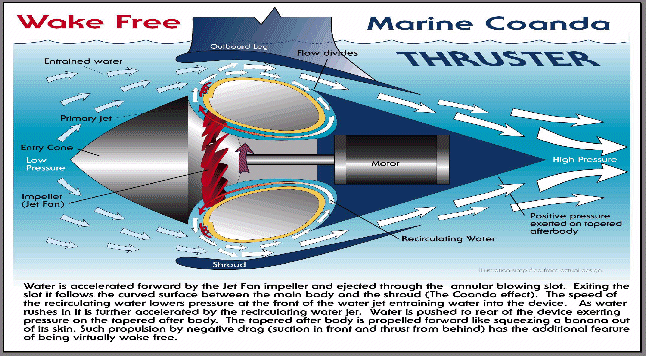
We have started our JET FAN R & D eight month program and will be very pleased to reveal these results, graphics and prototypes during the next military EUROSTATORY International Expo in Paris in June 1996.
All genuine enquiries for fan production for the Defence and Avionics market (such as cooling systems and air-conditioning in cells, cockpits, shelters) and for Medical and Transportation market s (such as air-conditioning and air-renewal in buses, tramways, trains, subways, etc....) can be addressed to:
Mr Chapalain / LMB Director
36 Ave Curie - Malemort
FRANCE
Fax: ± 33 55 92 29 00
Currently, LMB on behalf of JET FAN Technology is developing a computer designing software package for these applications. The first JET FANS are expected to be in production in the second half of 1996.
LMB is happy to have this statement published in future JET FAN Technology brochures and will consider seriously any JET FAN production enquiries concerning our specific market.
If you need further information please let me know.
Rene Chapalain
Managing Director
Is it noisy?
No. Noise from a fan is due to air turbulence. The "Jet Fan" drives high pressure air into a high pressure area. This makes it much quieter than other fans.
Is It Expensive to buy?
No. It will be no more expensive than the present day conventional fans it replaces. It may be less expensive due to it's smaller size and not needing a diffuser.
Will electric motor manufacturers be resistant due to higher speed requirements?
No. Almost all applications require no motor changes at all. Only a very few situations where a brushless electric motor is required for noise considerations will a one stage gearbox be needed to increase fan speed.
Will manufacturers resist change due to expensive plant changes?
No. Although the "Jet Fan" is a vast improvement over todays conventional fans, it is still after all only a fan from a manufacturing viewpoint.
With spherical hubs, shrouds and moveable blades, surely it is more complex and therefore more difficult to produce?
No. The more complex versions are for more exotic, high stress or special situations, mainly transportational, where pressures and thrust requirements change from second to second.
90% of applications including household ones need no speed change. The blade convergence is matched to the fan speed and the blades are an integral part of the hub and are cast or moulded in one piece as with other fans.
Will it be expensive to run?
No. The "Jet Fan" gives higher efficiency than other fans of the same size. In other words it uses less electrical power or fuel than others to do the same job.
Is there a lot more research and development needed before the fan is ready to licence to manufacturers?
No. Most applications of the fan are ready now. The pressure versus flow rate, the pressure being developed between the blades and the high efficiency in very small sizes, have all been proven. The "Jet Fan" is ready for manufacturing now.
The more complex versions including multi-staging as a compressor need more development time. We believe this period will not be long.
Is its high speed dangerous or a disadvantage?
No. We have not run it as fast as many conventional domestic vacuum cleaner fans yet.
What is the reaction from the engineers to such a simple improvement?
We have had many fan engineers and other technical people witness our fan demonstration test runs. We have had no negativity and only great enthusiasm from all.
What does buying or using an appliance with the "Jet Fan" mean to the average consumer?
The consumers work will be more efficient thus saving time and money. It also means a reduction in the consumption of fossil fuels for the production of electricity to supply appliances. The reduction of fossil fuel consumption will have a positive effect on green house gas emissions and the environment.
If you require additional information about the previous article and pictures may I suggest you contact
Split Cycle Technology Ltd
7 Technology Drive
Arundel
Queensland 4214
I suggest you forward your enquiries to these locations as I unable to offer any additional information on this remaarkable invention The pictures and the part article were taken from a CD purchased from this organization I recomend it Geoff
Website Split-Cycle Technology Ltd